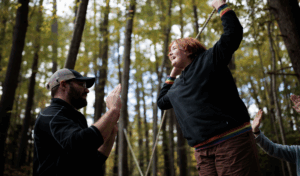For most adults, summer evokes a sense of ease—time off, warmer days, fewer demands. It’s natural to assume that teens feel the same. And for many, they do. But for adolescents with anxiety, summer often brings less relief than expected. Some teens even become more dysregulated once school ends. Parents may wonder: How can my child be struggling when the stressors of school are gone? Isn’t summer supposed to be the easy season?
From a clinical perspective, there’s a clear explanation—and a path forward.
Why the Absence of Pressure Doesn’t Always Equal Peace

During the school year, structure provides containment. For an anxious teen, daily routines—waking up, attending classes, managing assignments—can serve as external regulators that help keep internal distress in check. While these routines may create pressure, they also offer predictability and rhythm.
Summer removes that structure. Days become unbounded. Routines dissolve. And for many teens with anxiety, this shift creates a destabilizing vacuum. Without a framework to organize time, they feel unmoored. Uncertainty increases, and with it, so does anxiety.
This speaks to a core trait in anxiety disorders: intolerance of uncertainty. The anxious brain struggles to tolerate the unknown, often preferring the discomfort of overstimulation to the perceived threat of having nothing to anchor to. In this context, summer’s wide-open freedom can feel less like a break and more like a cliff.
How the Anxiety Maintenance Cycle Shows Up in Summer
One of the most common patterns seen in anxious teens over the summer is a rise in avoidant behavior. With fewer external expectations, teens may begin to opt out of discomfort—social interactions, physical activity, even basic responsibilities. What may initially look like rest or “needing a break” can, in reality, become a retreat from the world.
Clinically, we understand this as the anxiety maintenance cycle: anxiety prompts avoidance, which provides short-term relief, which in turn reinforces the anxious belief that the avoided thing is dangerous. Over time, avoidance shrinks a teen’s world. What started as taking a few days off can quickly become chronic social withdrawal, disrupted sleep, loss of motivation, or increased reliance on maladaptive coping strategies.
At the same time, other teens go in the opposite direction. Sensing their child’s discomfort with open-ended time, some parents overcompensate—stacking the summer with camps, classes, college prep, and travel. While structure can be protective, overscheduling an anxious teen can trigger overcontrol, perfectionism, and performance anxiety, especially in those who mask their distress with high achievement.
In both scenarios—withdrawal or overdrive—the teen’s anxious nervous system is not regulating. It’s reacting.
Nervous System Dysregulation in the Absence of Anchors
Anxiety is not just a cognitive experience—it’s physiological. During the school year, daily movement, social engagement, intellectual stimulation, and consistent routines all serve as regulators. They provide feedback loops that help organize the nervous system.
When those inputs disappear, it’s not uncommon for teens to become dysregulated. Parents may observe increased irritability, emotional lability, fatigue, or somatic complaints (like headaches or GI issues). Sleep patterns may become erratic. Motivation may plummet. And without the demands of school to mask it, underlying distress rises to the surface.
This is why “just relaxing” rarely works as a strategy for teens with anxiety. The nervous system requires intentional regulation—not just time off.
What Can Parents Do?
There’s no universal summer strategy that works for every teen. But there are a few clinical principles that can help guide parents in supporting their child’s emotional health:
1. Create Light but Reliable Structure
Daily anchors—consistent sleep/wake times, meals, light physical activity, scheduled therapy—can restore rhythm without overwhelming. The structure doesn’t need to mimic school but should provide a scaffold to help the teen feel contained.
2. Watch for Patterns of Avoidance
Avoidance is the hallmark of anxiety. If your teen is consistently retreating from social situations, physical activity, or new experiences, it’s important to interrupt that pattern gently but directly. Help them take small steps back toward engagement—even when it’s uncomfortable.
3. Support Regulating Activities
Encourage movement, time in nature, creative expression, and face-to-face social interaction. These all support nervous system regulation. Excessive screen time, isolation, or late-night sleep schedules tend to do the opposite.
4. Don’t Wait for Motivation
Anxious teens often say they don’t “feel like” doing things that might help. Waiting for internal motivation before acting only reinforces avoidance. Instead, use behavioral activation—support them in engaging first, with the understanding that motivation often follows action, not the other way around.
5. Separate the Teen from the Anxiety
When teens push back on plans or resist doing hard things, it’s often the anxiety talking. Help them externalize it: “I wonder if your anxiety is telling you this will be too hard. What would it be like to push back on it instead of listening to it?”
6. Model Calm Executive Function
Anxiety thrives in ambiguity. If parents leave every decision up for negotiation, anxious teens will often default to avoidance. It’s okay—and often necessary—for parents to make calm, confident decisions, especially when anxiety is driving the conversation. Being empathic doesn’t mean being passive.
A Different Kind of Growth
Summer doesn’t have to be perfect. It doesn’t need to be packed or left entirely open. What it can be is a space for developmentally appropriate challenge, nervous system recalibration, and increased emotional awareness.
Anxiety doesn’t take a vacation—but that doesn’t mean teens can’t learn to navigate it with more confidence. With a balance of routine, rest, and gentle exposure to discomfort, summer can be a season not of avoidance, but of quiet growth.


